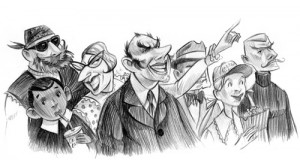ARE YOU RESPECTED FOR YOUR ARTISTIC ABILITY?
I Don’t think Illustrators get the Respect they Deserve.
What do doctors, lawyers, and CPA’s have in common aside from all that schooling? Probably the respect they get for their profession. Sure people often get a second opinion but they don’t go to the plumber – they go to another doctor, lawyer, or accountant.
I’ve wanted to write about this for a while because it irks me that in our profession we’re often not treated as the experts we’ve worked so hard to become. Let me begin by eliminating most of the children’s picture book editors from my upcoming rant. I’ve never been treated more like a professional than by my picture book editors. I’m talking about the clients we’ve had who don’t respect our schooling and work experience in freelance illustration. Do you ever feel trapped by your work? Hopefully this post will help you re-evaluate the people you choose to work for.
Death Design by Committee, Death of a good Illustration
I find it really troublesome that we are often asked to make arbitrary, superfluous, unnecessary, and downright stupid changes that ruin the design and composition by clients that have no art training. It’s the equivalent of me telling my surgeon where and how to cut – my attorney what motions to file and my CPA what strategies he should use to save me money. Don’t get me wrong – I’m not talking about back and forth conversations about art direction and options to consider before beginning sketches – and I’m not talking about good feedback on sketches or final art. I’m talking about bone headed decisions like eliminating colors that the art director happens to personally dislike. I’m talking about cluttering up good design with extra elements that don’t enhance the story or eliminating elements that are important to visual literacy. I’m talking about making content changes based on fear and most importantly the all too familiar “design by committee approach”.
What is Design by Committee?
What is “design by committee” you ask? It’s when companies (often educational text book or software companies) have multiple team and management members that have to “sign off” or agree on all stages of the artwork before it can be approved and the artists are allowed to proceed. For instance, the illustrator receives the assignment and emails sketches to his/her art director. The one person who understands art and good design, the art director isn’t respected or trusted to make decisions and approvals either! The sketches must pass by each team members desk. This sets up a dicey situation for each team member as well. If a particular person in this chain likes everything he or she sees – he or she might feel that he or she isn’t doing his or her job by sending it through without changes. Since nobody in this donkey conga line wants to appear lazy they conjure up changes they often don’t believe in and punt to the next drone. Sometimes I find myself stifling the laughter listening to the poor art director trying to justify conflicting moronic changes that even he/she doesn’t believe in.
The result is a bunch of sketches sent back to the illustrator marked up like a failing high school research paper. I’ve gotten them back looking like college football play charts. It’s interesting to me that this hasn’t been my experience in the picture book world – and picture books cost tens of thousands of dollars more to produce than a few pages in a text book. With my picture book projects I get very thoughtful comments and requests that are sensitive to my intentions and desires. We work back and forth to find solutions that address concerns but it’s not dictatorial by nature and there certainly aren’t the sheer quantity of rage conjuring idiotic arbitrary “one for the gipper” comments.
Why Aren’t Artists Trusted for their abilities?
What is it with art? Why aren’t our skills appreciated and trusted? Why do people think they can direct a painting when they don’t know how to design, draw, or paint? Why do people think they can publish without hiring skilled graphic designers? Graphic design is a science unto itself yet for some reason it seems to be a skill that is greatly under appreciated. I mean am I missing something? Do we hire college soccer coaches who have never played soccer? Do we hire conductors who have never studied music? Do customers go into the kitchen to tell the head chef how to cook the dish?
The answer can most likely be traced back to our schooling. Since it was never taught as a serious subject to all of us beginning in elementary school it is a discipline that is grossly misunderstood by the masses. “But Will, medicine, law, and accounting weren’t taught broadly either. Yes, but each of them have a level of mystery that are inherent to each discipline. Art on the other hand is very accessible. We see it for what it is. We can own it, touch it, commission it, clip it, steal it, share it, print it, etc. But does access devalue it’s creative process? Apparently so to some. (sarcasm intended)
Lately I have been listening to my client incompetence radar and turning down assignments that smell of the aforementioned disrespect. I love working on a good project with a great art director, editor, creative director, etc. – but life is too short to spend bitterly and angrily working with people who don’t value what I bring to the table.
What Can We Do?
If you’re serious about this business you can do a few things to help yourself and your fellow illustrators. If you find yourself in a situation like I’ve mentioned you can be respectful and politely challenge decisions if they are contrary to your artistic sensibilities. Don’t challenge for the sake of the challenge and when you do challenge – be solution oriented. Try to get what you want by offering another option that achieves what your art director wants while giving you more of a change you can live with. Agree to making some changes that you don’t agree with to help you win a few of the the more important battles. The better we are at communication – the better clients we will ultimately share.


